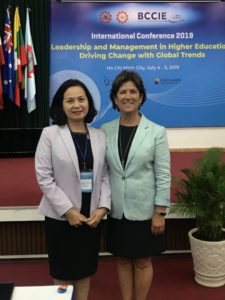As chair of the British Columbia Council for International Education (BCCIE) board, Camosun president Sherri Bell travelled to Vietnam in July to deliver a keynote speech at the Southeast Asian Ministers of Education Organization (SEAMEO) conference. At her presentation, Bell shared how Camosun embeds student learning in local businesses and community.
“I went through our community partnerships, our Indigenous community partnerships… The last part of it, I talked about our overall mission statement at Camosun—we’re an applied, relevant learning institution,” says Bell.
As second nature as this philosophy is to Camosun, Bell says that it’s a novel way of thinking about education in Vietnam.
“That’s the place where they’re at right now—trying to figure out how what we’re doing can be replicated in their country,” says Bell.
But with the drastically different styles in education, Bell says that there were takeaways that can better Camosun as well.
“I heard a presentation from a woman from Australia,” says Bell, “and she was talking about just how they track student involvement in other kinds of things outside of the classroom, so that they can be credentials for them.”
Bell met with the speaker after her speech and asked if she could see the system they use.
“Over the summer sometime, I’m going to get into it and look, just to see how they’re doing it,” she says, “because it is something that, when you look at the world of education right now… We have at Camosun certificates and diplomas and degrees; students are looking for other alternatives.”
These alternatives include “badging” and “micro-credentials”; in other words, packaging the life experiences that students have had, says Bell, so that it counts for something.
“It’s something that I’ve been researching with other institutions,” says Bell. “I had a conversation with BCIT about what they’re doing and this kind of fed into something that was of interest to me to research, so here I was in Vietnam listening to someone from Australia, and now I have a connection.”
Another aspect of the trip for Bell was outreach; she says that Vietnam is the market that has improved the most for drawing students to Camosun, although she says the point isn’t just to get international student numbers up.
“The major focus we’ve had in international education is to diversify,” she says, “not to increase our numbers tremendously.”
There are students at Camosun from about 75 different countries, says Bell; the college doesn’t have a lot of students from Vietnam, but over the last four years, the number has been steadily on the rise.
“It’s a country that we’re working pretty closely with, both in my role as president at Camosun, and as chair of BCCIE,” says Bell.
Bell says that the most memorable part of the trip was a conversation she had over dinner with SEAMEO center director Ho Thang My Phuong.
“I learned about where she went to school, where she grew up, just her journey,” says Bell.
Part of that journey was getting posted to her first university teaching position, says Bell.
“I said, ‘What do you mean, “posted?”’ She said, ‘The government tells you where you’re going to go work.’ We got into a conversation about the country, and where it’s come from the 1970s until now—what she’s proud of. It was an individual opportunity to build a relationship with someone who’s doing a similar job to what I do in a completely different country. The most interesting thing that you come away with are what people give you.”

